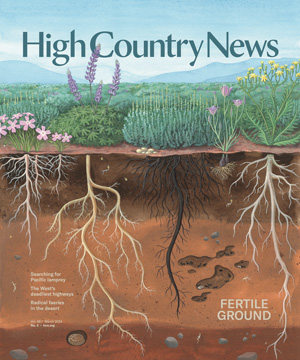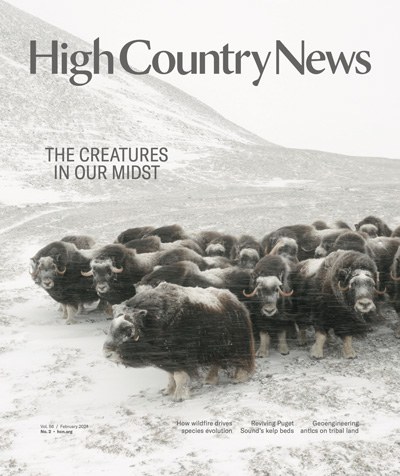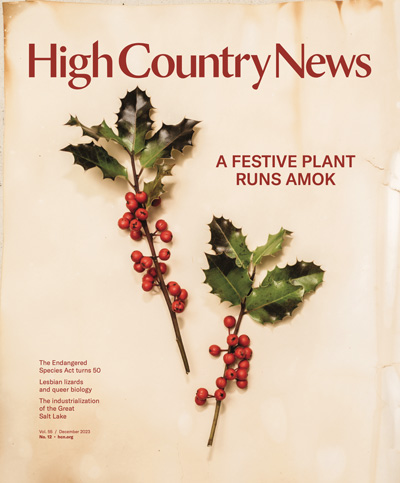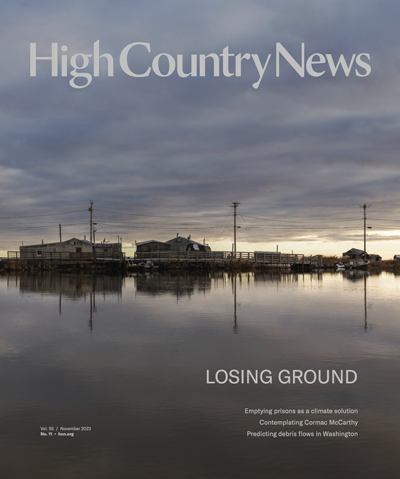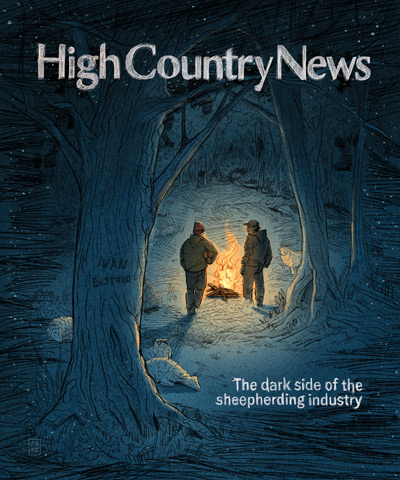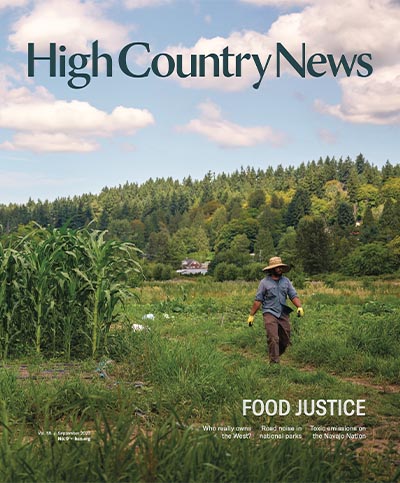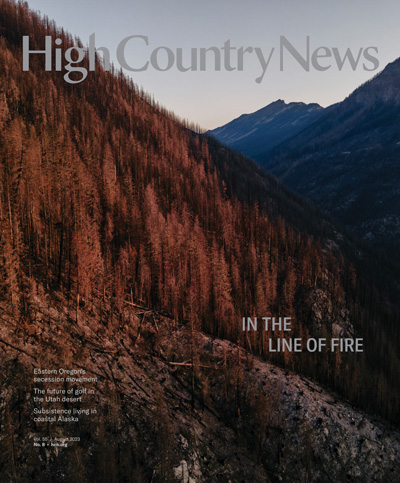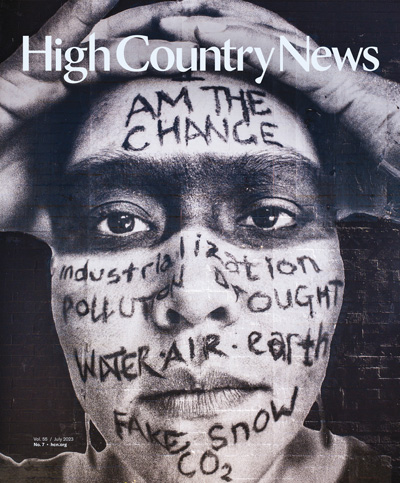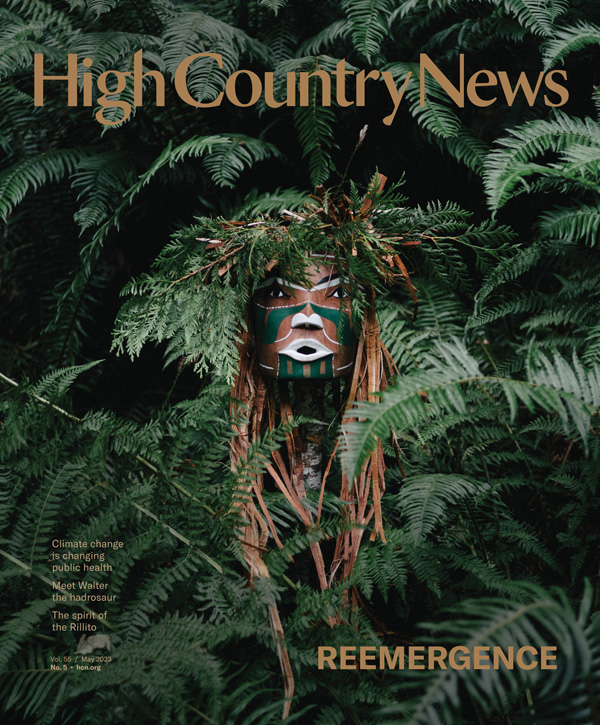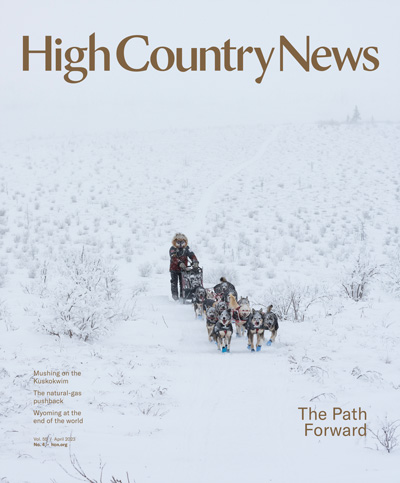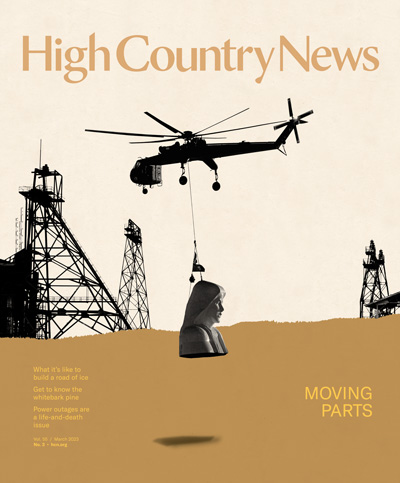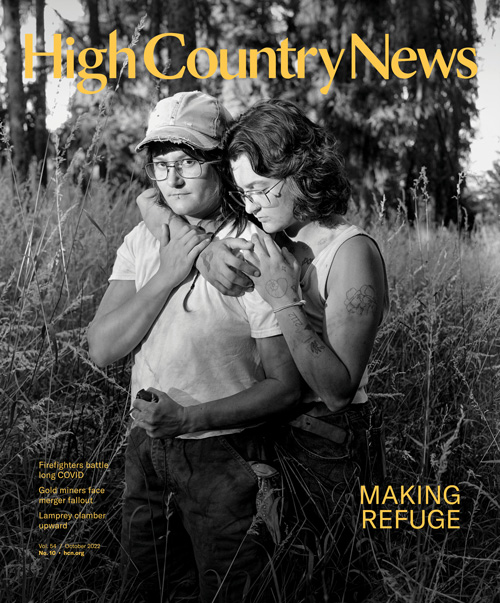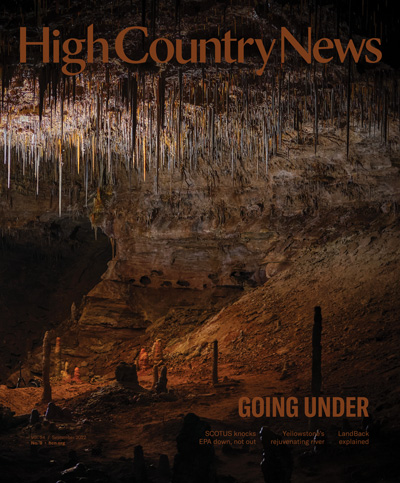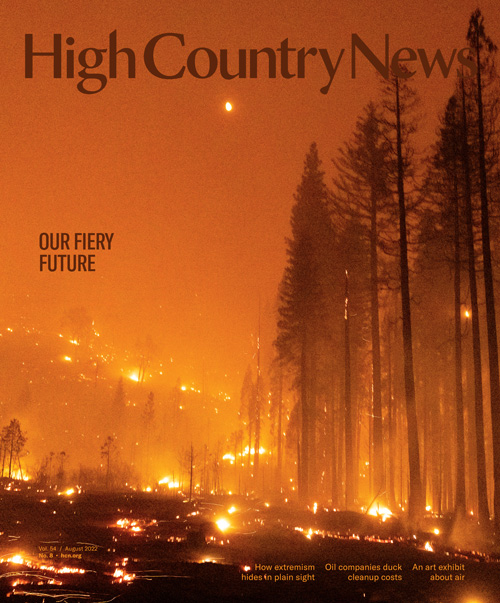It’s easy to feel overwhelmed during difficult times, but HCN’s March issue finds good reason to hope. Our two feature stories highlight the resilience of both human relationships and damaged ecosystems, with a photo essay about the lessons learned from older lesbian couples, and a wide-ranging survey of “natural regeneration,” the way that native seeds can survive underground, sometimes for centuries, waiting for the right conditions to sprout and flourish. We rediscover the Japanese-language poetry written in the U.S. between the world wars and meet gay men who found new community in the desert. But challenges remain: The toxic levels of PFAS in drinking water are often hidden from consumers, our car culture is killing us and our communities, and first responders are scrambling to keep up as immigration patterns shift and the death toll rises. Meanwhile, activists work tirelessly to find homes for unhoused Indigenous people, while researchers track Pacific lamprey to ensure the survival of an ancient and elusive species.
The Magazine
February 2024: The Creatures in Our Midst
Can we learn to get along — not just with people, but with other species and cultures? In this issue, one of our feature stories looks into the contentious relationship the residents of Nome, Alaska have with musk oxen – photogenic animals with a tendency to trespass and attack people’s dogs. Wolves are being reintroduced to Colorado, but how do you compensate wolf-hating ranchers when their livestock gets eaten? In our investigative feature, we found that renewable energy projects in Washington are trampling tribal cultural resources. The Samish are rebuilding kelp beds in Puget Sound, while the Northern Cheyenne restore ancestral lands, hoping to someday return water to Utah’s Great Salt Lake. Wild animals sometimes adapt, even to wildfires. A geoengineering company’s “just do it” approach clashes with tribal sovereignty. If new rivers open for salmon in Alaska and Canada, will extractive gold mines follow? A one-room rural schoolhouse in Montana thrives, while cannabis growers meet boom-and-bust. A chef’s hybrid world helps inspire hybrid recipes. An essayist suggests that humans don’t have to behave like invasive species.
January 2024: How to Build a Better Climate Future
In this special issue, High Country News reminds Westerners that it’s not too late to create a better climate future. One feature story takes a deep dive into the Tijuana Estuary on the California-Mexico border, showing that restoration is an ongoing process that can succeed when human beings devote themselves to it, for a lifetime if necessary. Indigenous leaders bring their knowledge to the climate change discussion, and the Smokehouse Collective works to rebuild Native food networks across Alaska. An 80-year-old electric co-op commits to decarbonization, and there are steps we can take to decarbonize the grid. California’s former insurance commissioner believes insurance companies and homeowners can take a more proactive approach to dealing with risk, and a diehard proponent of cooking with gas finally changes her mind. Environmental activists and labor unions achieve solidarity, and overlooked genres of literature, including Chinese tales about kung-fu heroes, can help grow a reader’s climate consciousness.
December 2023: A Festive Plan Runs Amok
The Endangered Species Act turns 50 this year, so HCN devoted a special section to this landmark environmental law. These stories take a hard look at its history, successes and failures, its complicated legacy in Indian Country, and possible strategies to prevent extinction altogether. Our features tackle other challenging issues: Conservationists are fighting English holly in Northwestern forests where the beloved Christmas symbol is becoming a pesky invasive. Meanwhile, Denver’s Globeville Elyria-Swansea neighborhood was long divided by Interstate 70, but residents fear that a project designed to reconnect the community will spur gentrification. Montana’s new laws encourage development, but will locals be able to afford the new housing? Utah’s Great Salt Lake is dying, but that hasn’t stopped the nearby industries from continuing to exploit it. Elsewhere, an unexpected encounter and a piece of jewelry spark a poet’s career, and a New Mexico lizard becomes a gay icon.
November 1, 2023: Losing Ground
The climate crisis affects everything, from where we live to what we eat to how we deal with crime. In Washington, extreme weather and COVID-19 pushed over-strained prisons to the brink, leading some to ask: Why not let people out? In Kasigluk, Alaska, buildings are succumbing to rising sea levels and melting permafrost, but relocating entire communities isn’t easy. Eureka, California, wanted to build affordable housing in parking lots, but opponents are exploiting an environmental law to fight back. The danger’s not over when the wildfire ends: Debris flows can be deadly. Trucking young salmon past dams seemed like a great idea, but what happens if the adult fish can’t find their way home? Can Green River, Utah’s famous melons survive climate change? Montana ranchers come together to start their own meatpacking facilities. An Indigenous writer reflects on everything his mentors taught him. Though DACA failed Tony Valdovinos, he still pursues his dreams. Just walking through a beloved landscape can help ease the pain of grief.
October 2, 2023: The Dark Side of the Sheepherding Industry
Our feature story in this issue tells the harrowing story of two Peruvian brothers who came to Wyoming to be sheepherders, only to find themselves virtual prisoners, forced to labor under abusive conditions. In an excerpt from a new book, we learn how California’s Coachella Valley reinvented itself as an Arabian Nights fantasy to market the delicious dates it grew. Wildland fire dispatchers’ jobs are exhausting, stressful and woefully underpaid; invasive smallmouth bass threaten the Grand Canyon’s native fishes, and new legislation is bringing clean energy jobs to the West. You have to locate native bumblebees before you can protect them. A good snow year doesn’t mean a good snowpack if sublimation steals away the snow’s moisture, and renting in gentrified San Francisco is never easy. A writer consider Justice Scalia’s thoughts on waterways as she enjoys them; and digging around outdoor — whether for roly-poly bugs or dinosaur fossils — will open your eyes to wonder.
September 1, 2023: Food Justice
This month, we learn about past injustices and ongoing environmental harms. An Asian American artist and a poet revisit the 1885 Rock Springs Massacre, when white miners murdered Chinese immigrants and burned down their homes. Wildlife isn’t safe from human noise or roads, even in national parks. Who really owns the West? Toxic emissions from oil and gas wells are hurting the Navajo Nation. The Black Farmers Collective seeks to encourage Black farmers in Washington, and Indigenous healers are finding new ways to treat the lingering trauma of the boarding school era. With climate change and wildfires causing a rise in overdoses, harm reduction workers try to keep people safe during times of environmental crisis. Why build a Biosphere 2 when we can’t even take care of Biosphere 1? A trickster spirit and a mischievous bird help a young queer man accept himself, while an Asian American woman with a neurodiverse son finds a way to cope with stress and racism on a family vacation out West.
August 1, 2023: In the Line of Fire
This month, HCN heats up with two very different fires: A genuine backcountry inferno, and the kind of political blaze that smolders and periodically threatens to blow up. Kylie Mohr follows two hikers who were caught in a Northern Cascades wildfire, while Leah Sottile looks at the “Greater Idaho” movement. Can outdoor recreation adapt to our changing climate, and why do so many white supremacists want to secede from Oregon? Elsewhere, we examine the 1872 law that governs hardrock mining, study the “forever chemicals” polluting our water, and learn how captive-born Mexican wolves are fostered in the wild. Can golf survive in the desert? Indian law experts discuss the Supreme Court’s ruling upholding the Indian Child Welfare Act. Denver once bragged about being a “sanctuary city”; what happened? The Japanese American National Museum honors those who were incarcerated during World War II, and historians remember the hardworking children of Southern California’s Filipino immigrant farmers. Finally, we share the joy of late-summer salmon fishing in Alaska.
July 1, 2023: Waiting for Water
This month, we take an in-depth look at life in Indian Country. HCN and ProPublica’s four-part package reveals how Colorado River Basin tribes in Arizona — including the Navajo, Chemehuevi, Hopi and Tohono O’odham — must fight for every drop of the water they were guaranteed by a 1908 Supreme Court decision. We consider the pros and cons of hunting bison just outside Yellowstone, and why Newtok, Alaska’s residents have had to wait decades to relocate while climate change destroys their village. And we feature a profile of Larissa FastHorse, the first-known Native American woman to have a play on Broadway, as well as a witty essay about one writer’s love-hate affair with Native romance novels. Elsewhere, U.S. and Central American climate migrants are fleeing to Baja California, and public education in the West is suffering from lack of funds. Did you know that elk and other wild animals have unique regional dialects? How can we help “horse girls” hold on to their wildness as they grow up?
June 1, 2023: Seen and Unseen
This June, we meet a remarkable woman: Letitia Carson, who was born into slavery and yet became the only Black woman known to secure a homesteading claim, despite Oregon Territory’s strict Black-exclusion laws. Now, Black Oregonians want to preserve the homestead site — without forgetting the Indigenous people who were forcibly removed from that land. A gifted photographer looks at rural life in Colorado’s North Fork Valley. Can geothermal energy help power the West? The Canada lynx is on the move as the snow it depends on recedes. Locals are becoming community scientists to protect the Salton Sea. HCN examines Wyoming Republican Rep. Harriet Hageman’s relationship with Indian Country, and we learn about making syrup from the Northwest’s bigleaf maple trees. Ohtani basketball is a Japanese American tradition in California, while queer culture flowers amid that state’s superbloom. We interview John Vallaint about Canada’s wildfires and his new book, Fire Weather. Jane Wong’s new memoir reveals how compulsive gambling tragically derailed an Asian American family — her own.
May 1, 2023: Reemergence
In this issue, our feature highlights a Makah artist who preserves the stories of his ancestors and their reciprocal relationship to whales. We also follow two female botanists as they raft down the Grand Canyon in an attempt to make the first recorded, botanical survey of the region. Elsewhere, a FEMA contractor’s incompetence in translating Alaska Native languages shows systemic problems. In a Colorado coal town, the discovery of a 74 million-year-old fossil brings a new kind of tourism. A team of epidemiologists in Washington prepares for climate change. In Wyoming, off-rez hunting is under scrutiny. Is the Behren’s silverspot butterfly valuable enough to save? Climate change refugia can shelter wildlife if the planet doesn’t warm too much. And finally, we check in with Debra Magpie Earling on her new novel, learn about the importance of good ice for hunting in coastal Alaska and think on the meaning of ‘new animism.’
April 1, 2023: The Path Forward
Challenging times call for innovation, and the West is as full of ideas as it is of problems. Chronic wasting disease is killing deer and elk throughout the Rocky Mountains, and with no cure in sight, some researchers think predators might help combat its spread. In Butte, Montana, ecologists work with engineers to keep migratory birds from landing on — and dying in — the Berkeley Pit. It makes economic and environmental sense to give up fossil fuels, but the natural gas industry is fighting electrification. Now that Roe v. Wade’s gone, startups are helping rural women get reproductive care. Women hunters shoot down stereotypes while feeding themselves and their families, and dogsled races keep traditions alive in Alaska. An Indigenous protest 20 years ago helped inspire Nevada’s newest national monument, Ave Kwa Ame. Real-life Jackson, Wyoming, is not quite the refuge it seems in ‘The Last of Us.’ Grigri or gris-gris? Outdoor recreation companies borrow words but not worldviews from Black and Indigenous communities.
March 1, 2023: Moving Parts
Western communities are complex, layered places, and that’s especially true of cities like Butte, Montana, whose hardscrabble mining history spawned social and political activism and a uniquely creative working-class culture, epitomized by “Our Lady of the Rockies,” a 90-foot-tall statue built by local men. In Long Beach, California, manicured golf courses and polluted neighborhoods co-exist in the shadow of the petroculture. Camera traps remind us that we share the world with wildlife. Railroad lines once connected most of the West’s far-flung communities — though rural Alaska prefers ice roads when its rivers freeze in wintertime. Black Americans are moving to South Phoenix in record numbers. We need renewable energy, but not at the price of green colonialism. The whitebark pine is struggling to survive. Power outages are a life-and-death matter for people with disabilities. A Wyoming family leans on luck to get by, and the personal and political overlap amid the beauty of Yosemite.
February 1, 2023: The Reveal
Our changing climate is already transforming the West. In this issue, we visit a shrinking Lake Powell and witness the surprisingly swift return of Glen Canyon. The disappearance of Utah’s Great Salt Lake revives Latter-day Saints’ interest in environmental thinking. California’s forests are dying. When rising sea levels and destructive tides began gnawing away at its beach, one Washington community built a berm to counter erosion. Missoula, Montana, wants to guarantee public access to a ski hill on its outskirts. Why not power the West by putting solar panels on big-box stores and parking lots? The Biden administration is reshaping land management through tribal co-stewardship of public lands. A new book, Profit: An Environmental History, neither centers the environment nor demonstrates real understanding of capitalism. Los Angeles’ Hammer Museum examines Joan Didion’s relationship with the West. A simple glass shelf can embrace a lifetime of memories, and the year-round harvest of Alaska Native foods amply fills a family’s table in the wintertime.
January 1, 2023: Ripple Effects
We begin the new year facing serious problems, so in this issue we look for possible solutions. Our feature considers proposals to breach four dams on the lower Snake River, which would benefit endangered fish and Indigenous tribes, but harm local farmers and the river’s industrial users. A proposed wildfire-risk map ends in ashes in Oregon, while Indigenous women respond to innovative workshops on prescribed and cultural burning. In Colorado, scientists employ assisted migration, moving Rio Grande cutthroat trout to cooler waters. Locals fight to save black walnut trees while fending off gentrification in Northeast Los Angeles. Washington’s shellfish farmers contend with climate change, immigration crackdowns and housing. Pima County, Arizona’s medical examiner sets new standards for identifying deceased migrants in the Borderlands. What will a third consecutive year of La Niña mean for Western weather? Saudi Arabia’s ties to Arizona predate current controversies over groundwater pumping, and growing up gay in conservative Colorado Springs was even harder than you think.
December 1, 2022: Beyond Illusion
This issue takes us into the Mojave Desert, reminding us that landscapes too often dismissed as wastelands have always been home to Indigenous cultures and complex ecosystems. Our feature profiles artist Kim Stringfellow, who has devoted years to interrogating the desert’s history. We visit other unique landscapes, from the Great Basin’s vanishing sagebrush sea to Montana’s alpine peaks, where a strange pink algae is hastening the already rapid snowmelt. We ask uncomfortable questions: After June’s deluge, will developers rethink plans to build in the Yellowstone River’s floodplain? Is carbon capture really a viable solution to climate change? Will Indigenous nations finally receive their share of the Colorado River? And we explore some human ecosystems, honoring the stories of Diné boarding school survivors and the hidden histories of queer folk; chatting with customers on closing day at a diner in St. George, Utah; resurrecting family traditions with homemade fruitcake and watching a new life is rooted underneath a Wyoming juniper.
November 1, 2022: The Futures of Conservation
In this special issue, we take an in-depth look at the future of conservation in the West. Experts agree it’s time to upgrade the environmental laws of the 1970s. Chuck Sams, the National Park Service’s first Native director, hopes to lead the agency in a more inclusive direction. Collaboration keeps political extremism at bay in Oregon, seeks to protect eagles from lead poisoning and works to preserve wildlife corridors on both sides of the Borderlands. In Oregon’s Willamette Valley, a small butterfly once thought to be extinct makes a remarkable comeback, while in Colorado’s San Luis Valley, activists forge a sustainable life that reflects their multicultural heritage. On Alaska’s Tongass National Forest, Indigenous youth learn to be stewards of both the land and their culture. Science fiction needn’t be dystopian. Watch out for ecological amnesia: We can’t create a livable future unless we remember our past and pay heed to our present.
October 1, 2022: Making Refuge
An unexpected theme runs through our feature stories – the idea of “Making Refuge” in the West – as we consider how humans and other species can work together to enhance our mutual survival. June T Sanders’ photos and Abigail Hansel’s essay celebrate a community on the Washington-Idaho border that thrives despite anti-trans paranoia and extremism, while B. Toastie teaches us about the age-old relationship between lamprey and tribal communities in the Pacific Northwest. Alliances often spring up in response to crisis: Arizona mobile home owners facing extreme heat, wildland firefighters struggling with long COVID, Westerners working to ensure access to reproductive care. The challenges can seem overwhelming, as Nevada gold miners confront a powerful corporation, Indian Country awaits important Supreme Court decisions, and Westerners worry about the upcoming midterm elections. Arianne Zwartjes’ new book “These Dark Skies” doesn’t hesitate to confront modern-day brutality even as she looks for solutions. But Westerners still come together in joy, whether moose hunting in rural Alaska or discussing Native literature with Native writers in Montana.
September 1, 2022: Going Under
HCN prides itself on digging deep, but this month we literally go underground, accompanying Emily Benson into a Wyoming cave, where scientists who study cave formations hope that 100,000-year-old weather data can help us understand climate change. This summer’s flooding damaged property around Yellowstone National Park, but in the long run it might refresh the ecosystem. Despite a recent Supreme Court decision, the Environmental Protection Agency can still shut down polluters. There’s money in restoring landscapes ravaged by extractive industries, while Arizona citizens hope to protect groundwater with the help of a ballot initiative. Have you ever thought the land might be better off under new management — maybe the original management? The LandBack movement has suggestions. On the Navajo Nation, Indigenous farmers like Graham Biyáál are reclaiming traditional growing techniques and preserving seeds and recipes. If Biyáál’s blue cornmeal mush doesn’t fill you up, try visiting California’s Punjabi dhabas. We also review an enchanting new short-story collection and struggle to keep up with Cassie da Costa as she runs her first half marathon.
August 1, 2022: Our Fiery Future
August is hot, and so are the stories in this issue, which examine the West’s fiery future from a variety of angles, discussing how communities can work together to reduce fire risk; climate change and our “forever” fire season; recovery after devastating wildfires; and the weird underground fires that ignite in coal seams and sometimes cause raging aboveground wildfires. Elsewhere, we see the impacts of climate injustice in industrialized Wilmington, California, where residents fight cancer and other serious illnesses. What’s the one weird trick oil companies use to dodge those annoying cleanup costs? Just don’t pay them. We interview longtime HCN contributor Leah Sottile, whose new book shows how extremist beliefs can destroy the lives of ordinary people. In the mood for fresh air? Take a hike with the “School of New Art Geographies,” which brings together artists and scientists to do creative fieldwork in the Sonoran Desert. And enjoy our preview of the Utah Museum of Fine Art’s groundbreaking multimedia exhibition, “Air,” which opens our eyes to something we often take for granted.

